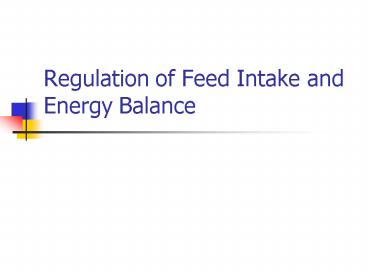Regulation of Feed Intake and Energy Balance - PowerPoint PPT Presentation
1 / 20
Title:
Regulation of Feed Intake and Energy Balance
Description:
Dramatic reduction after cessation of lactation ... Lactating cow increases her intake after calving. Non-lactating maintained fairly constant intake until ... – PowerPoint PPT presentation
Number of Views:376
Avg rating:3.0/5.0
Title: Regulation of Feed Intake and Energy Balance
1
Regulation of Feed Intake and Energy Balance
2
Regulation of Feed Intake and Energy Balance
- Long-term regulation of energy balance is
achieved by short-term regulation of meal-eating
and feed intake - Energy balance, not feed intake, is the
controlled variable in the homeostatic regulation
of feed intake
3
Regulation of Feed Intake and Energy Balance
Energy balance
Gut, liver, CNS receptors
Feed intake () Energy expenditure (-)
Hypothalamic centers
4
Relation of Intake to Energy Balance
- In simple-stomached animals fed medium to high
energy diets there is a simple negative relation
between intake and diet energy content
5
Regulation of Feed Intake and Energy Balance
Energy
Intake
Dry matter
Energy concentration
6
Relation of Intake to Energy Balance
- In ruminants (and probably, other large
herbivores) fed diets with a wider range of
energy concentration, the relation is more
complex (e.g. growing lambs).
7
Dry Matter Intake and Digestible Energy in Lambs
- Dry matter intake increases with dietary DE
concentration to a maximum point (about 2.5
Mcal/kg), then decreases with further increase in
DE concentration. - DE intake increases with dietary DE concentration
to the same inflection point (about 2.5 Mcal/kg),
then remains relatively constant.
8
Dry Matter Intake and Digestible Energy in Lambs
- Interpretation
- DE
- DE 2.5 Mcal/kg - intake is regulated by energy
demand
9
Short Term Regulation of Feed Intake
- Intake is usually measured on a daily basis, but
daily intake is comprised of a number of separate
meals, even when animals are fed ad libitum (e.g.
ruminants eat 10-15 "meals" per day. Should
therefore focus on regulation of meal eating.
10
Effects on Feed Intake
- Two important factors are
- Meal interval
- Meal size
11
Regulation of Meal Eating
- Feedback signals
- Receptors
- CNS centers
12
Regulation of Feed Intake and Energy Balance
Energy balance
Gut, liver, CNS receptors
Feed intake () Energy expenditure (-)
Hypothalamic centers
13
Regulation of Meal Eating
- Feedback signals
- Changes in regulated variables which lead to meal
eating being switched on or off - Physical distension (gut fill)
- Chemical VFA concentration, pH, osmolarity of
digesta - Endocrine/neuroendocrine numerous hormones
(insulin, leptin, ghrelin)
14
Regulation of Meal Eating
- Feedback signals
- Many signals operate at the same time
- Relative importance of different signals varies
with diet (e.g., roughages vs concentrates),
species (e.g., ruminant vs nonruminant) and
physiological state (e.g., lactating vs
nonlactating)
15
Regulation of Meal Eating
- Receptors
- Nerve ends which are sensitive to changes in
feedback signals - stretch receptors located in gut wall detect gut
fill - chemoreceptors located in various splanchnic
tissues detect VFA (rumen wall), glucose (liver
and other chemical changes
16
Regulation of Meal Eating
- CNS centers
- Where integration of afferent neural information
from receptors takes place, and efferent signals
to effector organs are initiated - mainly in hypothalamus
- separate centers stimulate feeding (lateral
hypothalamus) and satiety (ventromedial
hypothalamus)
17
Long term Regulation of Feed Intake and Energy
Balance
- Involves modulation of level around which short
term, homeostatic regulation occurs - The major factor driving these chronic shifts in
intake regulation is energy demand - e.g., rat before, during and after lactation
18
Feed Intake in Rat
- Over 400 increase in feed intake during
lactation - Dramatic reduction after cessation of lactation
19
Long term Regulation of Feed Intake and Energy
Balance
- Another influence is climate, which also affect
appetite via its impact on energy status - Chronic shifts in energy demand can override not
only metabolic but also physical feedback signals
- e.g., effect of lactation on maximum forage
intake of pasture-fed dairy cows
20
Long term Regulation of Feed Intake and Energy
Balance
- Lactating cow increases her intake after calving
- Non-lactating maintained fairly constant intake
until much later after calving































